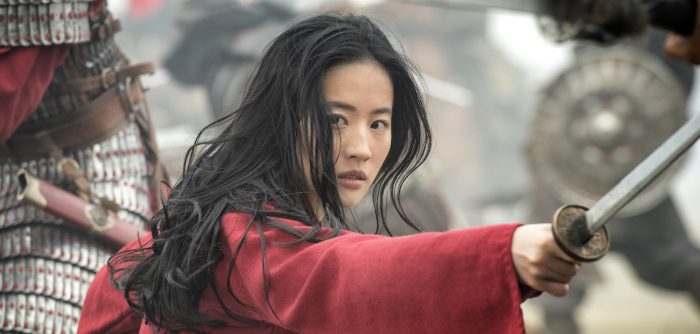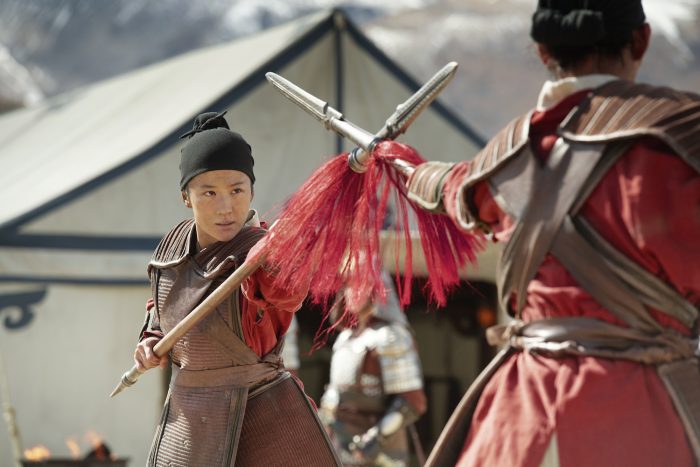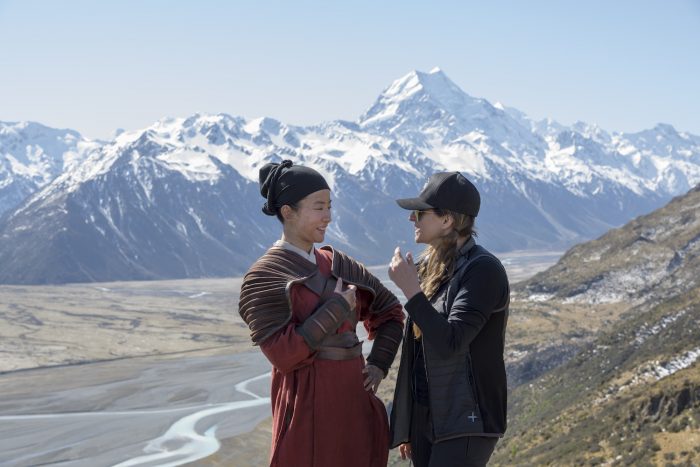
Resplendently armored Chinese army generals sit atop horses in a valley nestled in the middle of a mighty mountainscape, fluttering yellow and red flags surrounding them and dust billowing in from a wind machine. Not that they need one — the natural wind of the New Zealand countryside acting as the Chinese battlefield on the set of the live-action remake of Mulan is strong enough. It’s the kind of wind that blows through your hair until the separate strands cut into your face, and pierces through your coat to settle into your bones.
But Mulan star Liu Yifei is paying no mind to the wind, even as it whips her long hair around her face in such a wild frenzy that her eyes can barely be seen on the monitors. She’s poised, stony-faced, her simple robe the one bright flash of red among the weather-beaten, dirt-covered soldiers who ready themselves to charge against the invading Rouran army, a battlefield strewn with dead horses and soldiers stretching out between them. Yifei is running through the climactic battle scene of Mulan: the zenith of the film in which the mythic Chinese warrior has now revealed her identity to the world.

Waiting for Mulan
“Yifei, she is just Mulan,” costume designer Bina Daigeler tells a group of journalists visiting the New Zealand set. Kiwi director Niki Caro has taken the production of Mulan, the upcoming remake of the beloved 1998 animated film, to her homeland, where /Film was among those invited to view the film’s big battle scene between the Chinese imperial army and the invading Rouran army led by Jason Scott Lee’s vengeful warrior Bori Khan and Gong Li‘s mysterious taloned witch Xian Lang. It’s a scene that was a long time coming, as the Mulan production had been delayed and the live-action remake’s release pushed back so that Liu could step into the iconic armor.
“We waited for Yifei,” producer Jason Reed says. “Once we went through that search and we determined that Yifei was the person we wanted and that she had the correct spirit and the correct determination and work ethic…we had to wait. We pushed production 5 months, which was interesting. Also the previous release date, if I’m totally honest that first release date was a placeholder anyways, and it was some ways intended to scare off anyone who wanted to make a Mulan movie.”
There are certainly a lot of reasons to be scared to make a Mulan movie. The 1998 animated film directed by Tony Bancroft and Barry Cook was a beloved hallmark of the Disney Renaissance era and a cherished part of many moviegoers’ childhoods. And while Disney live-action remakes are basically guaranteed box office hits, fatigue has set in for the nostalgic rehashes critically. But there’s more riding on this film than the Disney label. Mulan is a famous figure in Chinese folklore stretching back centuries, with the original The Ballad of Mulan folk song dating back to the 6th century. China has released their fair share of Mulan feature film adaptations, including one that came out as recently as 2009, none of which have gained much traction in the States. But Disney nostalgia is a global business and the Chinese box office is one of the most lucrative for Hollywood — Caro and her team need to strike that perfect balance that satisfies both audiences.
“The traditional Disney audience and the diaspora Asian audience viewed [the animated Mulan] in one way and the traditional Chinese in China audience viewed a slightly different way,” Reed says. “So we really dug in to try and make sure we that we were addressing both of those audience in a thoughtful way.”
The differences Reed refers to mostly have to do with the zanier “Disney” aspects of the animated movie that are now some of the most beloved by Americans who grew up with the film. The fan-favorite character Mushu, played with wacky aplomb by Eddie Murphy, “didn’t play very well with the traditional Chinese audience” where the dragon is a sign of respect, strength, and power. Depicting the dragon as a “silly sidekick” was near-insulting to Chinese audiences, who also mocked the scene of Mulan cutting her hair — an empowering scene in the animated film that was very in line with the grrrl power feminism of the ’90s, but made no sense for Chinese men of the time, who wore their hair long.
“We thought about how we were going to approach this movie — and the world has changed quite a bit since the animated movie was made. So we went back,” Reed says. All the way back — back to the ancient folk song The Ballad of Mulan, which serves as the main inspiration for the film. The Ballad of Mulan is a Confucian parable that highlights the importance of duty to family and country. The feminist themes of the story aren’t actually present in the original (very short) ballad, which instead emphasizes the duty that every Chinese citizen has to the emperor, regardless of their gender. Mulan is seen as a symbol of virtue for her devotion to her family, and as such, has been upheld for centuries as one of the most beloved Confucian figures in China. Caro’s live-action Mulan remake leans into those elements — adding a younger sister, as one example — while still keeping some of the modern, feminist (and even funny!) elements that make the animated Mulan such a beloved film. “This is based on the poem but also employing some of the visual elements of the original animated film,” producer Barrie Osborne adds.
Confucian hero, feminist hero, national icon. That’s a lot of pressure to put on Liu, a Chinese-American actress who has carved out success for herself in the Chinese film industry — even getting named one of the most bankable actresses in China. But Liu resolutely shoulders the burden of playing an icon in both cultures she hails from, telling us that she only looks at the human within Mulan, not the hero.
“Although everybody knows the name, and everybody has their own picture of her, but to me, the hero is so human,” Liu says. “I think it’s all beyond words. You have to feel it as a human being.”

Bringing Honor to the Live-Action Remake
Liu is on the move again. Her long, flowing black hair seems to have taken on a life of its own as she dodges and weaves through the masses of Rouran soldiers. Suddenly the monitor we are watching the sequence on slows down to a snail’s pace, and Liu is moving in slow-motion, the pillowy plumes of smoke rising in clouds behind her as she twirls and slashes her sword, her red robes the one bright piece of elegance amid the muddy green battlefield. Powerful. Majestic. It’s enough to take your breath away before you realize, hey, this scene wasn’t in the animated movie. Instead of the short choppy haircut that Mulan gives herself in the iconic hair-cutting scene in the animated film, Mulan’s hair is long, and the Hun invaders have been exchanged for the more legend-accurate Rouran Khaganate and their ally, Li’s mysterious witch. The epic battle scene, which feels plucked straight out of a wuxia martial arts film, is a new addition for the remake by Caro and screenwriters Rick Jaffa, Amanda Silver, Lauren Hynek, and Elizabeth Martin. But these changes haven’t been made haphazardly to try to distinguish Mulan from the onslaught of uninspired shot-for-shot remakes.
“There’s been a number of movies that have failed in their attempts to tell Western versions of Chinese stories, or vice versa,” Reed says. “And so one of the things that was made clear to us from the very beginning was make a Disney movie. Don’t try to make the Chinese version of Mulan because they’ve already made it several times. And they’ve already seen it.”
Caro had the unenviable task of figuring out what exactly makes “a Disney movie” — essentially maintaining that balance of respecting both the Chinese audience and the nostalgic Disney audience — while creating something compelling. To help with the former, Caro had a council of Chinese advisors working with the team through the development and design phases, and bringing 25 different experts in various areas helping with design, costumes, makeup, architecture, and story. Stunt riders were brought in from Mongolia and Kazakhstan, while the vast majority of the stunt team is from China. The majority of the cast comes from the Chinese mainland, including Liu who, despite having dual American citizenship, has spent most of her career in China. Caro, a New Zealand-born filmmaker who won the directing gig after Disney initially sought out an Asian filmmaker, has stressed the importance of authenticity in her films based on cultures that are not her own, having crafted a female-led adventure story deeply embedded in a specific culture with Whale Rider, which follows a young Maori girl who aspires to be the chief of her tribe.
“I made Whale Rider, I saw that to be specific and authentic is to be universal, and I’ve continued to work in an identical way ever since,” Caro said in an interview with The Hollywood Reporter. “As the projects get bigger, the more certain I am that cultural authenticity and specificity is the only way to approach my work.”
Mulan gets more culturally specific than the 1998 animated film could have hoped to get (Disney sent its team of artistic supervisors on the animated Mulan to China for inspiration, but that was about the extent of it on the authenticity front). The live-action Mulan also makes a bid to better represent the diversity within China at the time, which, according to star Yosan An, who plays Mulan’s fellow recruit and love interest Chen Honghui, is inspired by the Tang Dynasty, an imperial dynasty that ruled between the 600s to 900s. During this time, the borders to China were more open than ever thanks to the Silk Road — opening the door for Mulan to feature South Asian characters like the one played by Pitch Perfect‘s Utkarsh Ambudkar.
“[With the Silk Road]…people from all over the world come together and it’s such a diverse culture,” An says. “In this film, the cast you’ll see people from different kinds of cultures interacting with each other and every single character has a multidimensional layer to them. So, it really does away with all the Asian stereotypes in all the other films. And with what Black Panther has done for its community, I really feel that Mulan is going to do the same for the Asian community as a whole — taking on what Crazy Rich Asians has done for the Asian community and empowering it before with the momentum it created.”
But with all this multidimensional diversity, what of the film’s invading army, which in the animated film — and in many Chinese retellings of the tale — were depicted as barbaric villains? Jason Scott Lee — who is no stranger to starring in Disney live-action remakes, getting his breakout role as the hero in 1994’s The Jungle Book — was allowed more dimension in his depiction of the film’s villain Bori Khan.
“The way I’m approaching it is that much like [how] colonialism pushed out native or indigenous cultures, Bori Khan’s fight is to regain and recompose his culture of the Rouran Khaganate,” Lee says. “And I shared my take with it with director [Niki Caro] and I think she said, ‘Well, that’s a good perspective, that the culture of the Rourans have been overrun by the Chinese.'”
Continue Reading Mulan Set Visit Report
The post ‘Mulan’ Brings Honor to Both the Animated Film and the Chinese Myth [Set Visit Report] appeared first on /Film.
from /Film https://ift.tt/2PvWGgB
via IFTTT
Comments
Post a Comment